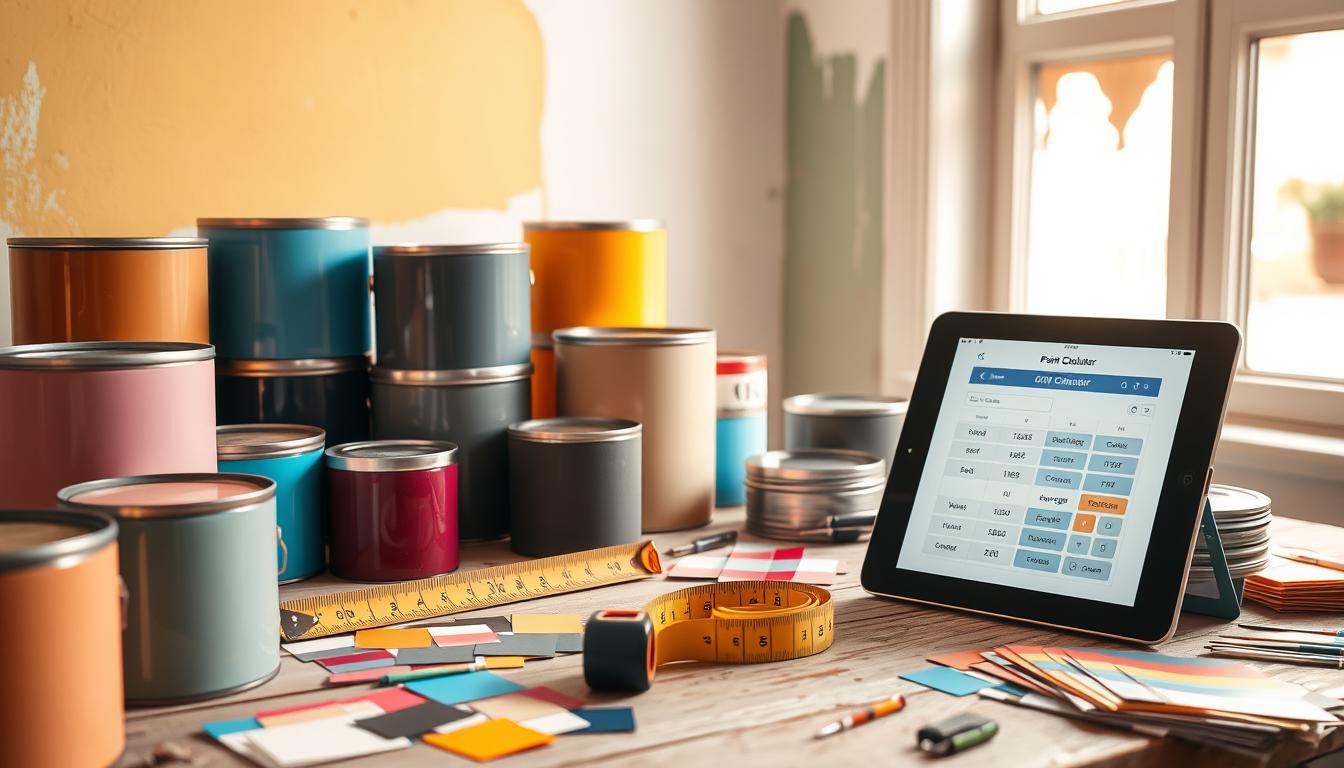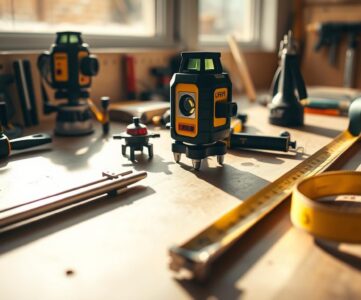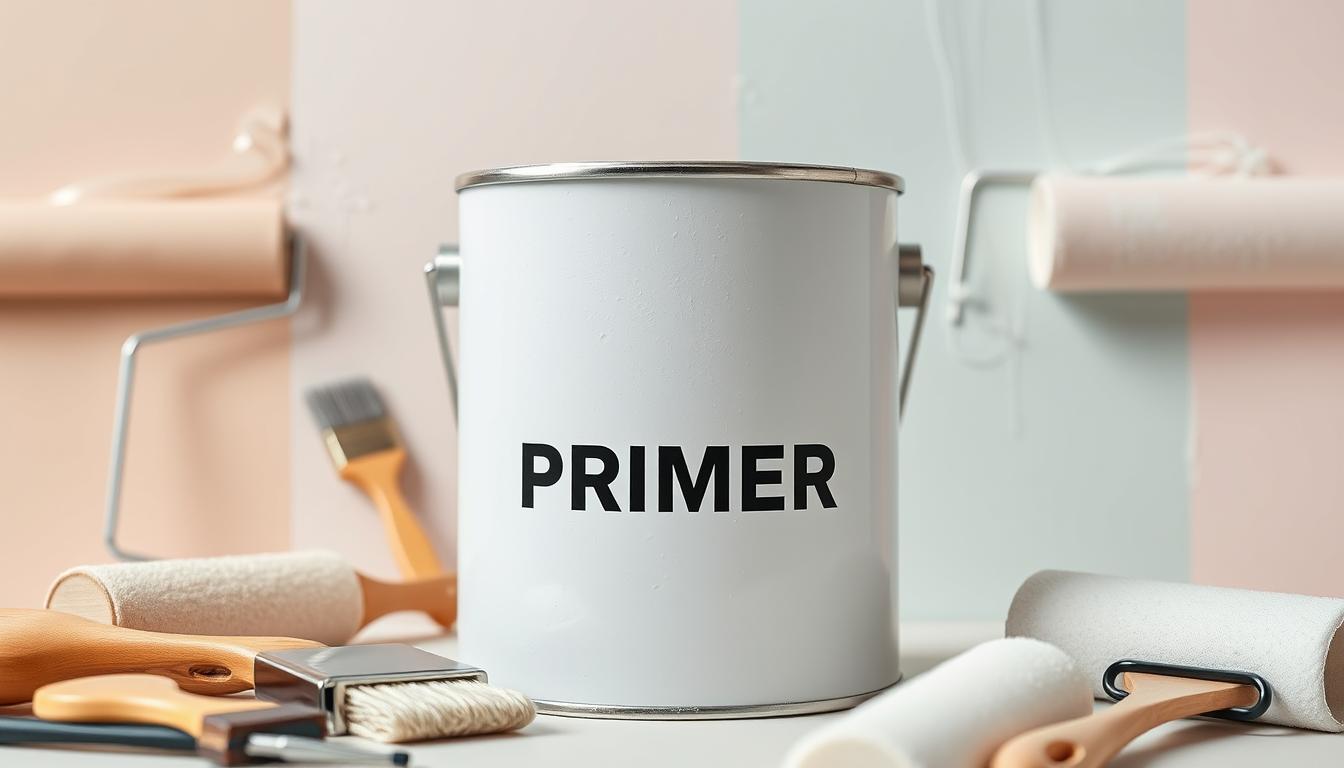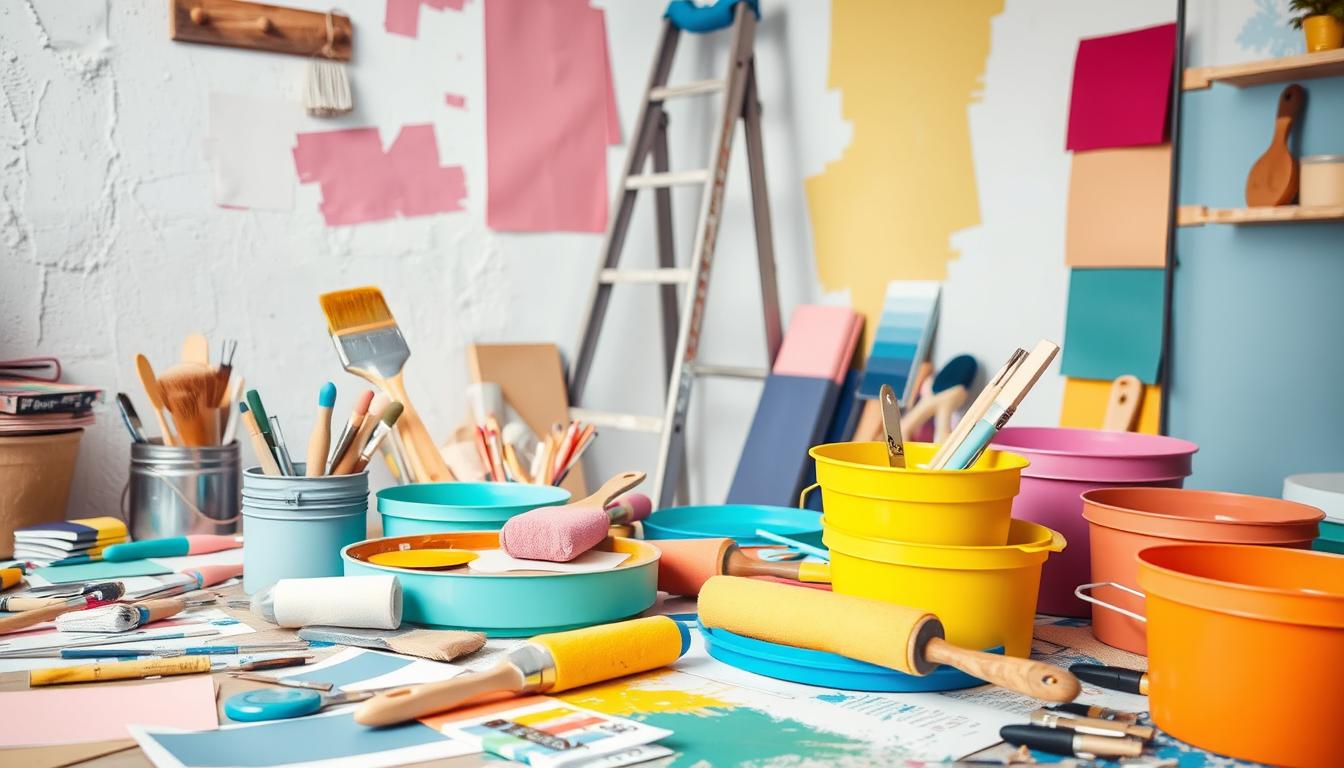Accurate paint quantity is vital for any project. A paint calculator streamlines this process, saving you time and money. It prevents paint waste and lessens environmental harm. This guide will show you how to use a paint calculator for precise paint amounts.
Accurate paint estimation is essential for a project’s success. A paint calculator makes it easy to figure out the needed paint amount. It considers the surface area and other factors that influence paint use. This guide will equip you with the tools and tips for precise paint quantity estimation, simplifying your project planning.
Key Takeaways
- Using a paint calculator can help you save time and money
- Accurate paint estimation is crucial for a successful project
- A paint calculator can help you reduce paint waste and minimize environmental impact
- Understanding paint coverage basics is essential for accurate paint estimation
- Considering factors like surface texture and paint type can affect paint consumption
- Using a paint calculator can help you make informed decisions about your project planning
Why Accurate Paint Calculations Matter
Accurate paint calculations are key to a successful painting project. Paint estimation goes beyond just guessing the paint amount. It involves material planning and cost calculation too. A well-planned paint job saves time, money, and reduces waste.
Mistakes in paint buying can waste time and money. Buying too much paint results in unused leftovers, while too little means extra trips to the store. Accurate paint estimation helps avoid these issues, ensuring a smooth painting process.
Common Paint Buying Mistakes
- Not considering the surface texture and porosity
- Not accounting for multiple coats
- Not measuring the space correctly
Accurate cost calculation prevents overspending on paint. By factoring in paint, labor, and materials costs, you can set a realistic budget. Material planning also reduces waste and minimizes environmental impact.
The Cost of Inaccurate Estimates
Inaccurate estimates can lead to high costs, including excess paint, labor, and materials. The environmental impact of paint waste is also significant, with millions of gallons discarded yearly.
Environmental Impact of Paint Waste
Reducing paint waste is crucial for environmental sustainability. Accurate paint estimation and material planning help minimize waste. This makes painting more sustainable.
| Paint Type | Environmental Impact |
|---|---|
| Latex Paint | Low VOCs, biodegradable |
| Oil-Based Paint | High VOCs, non-biodegradable |
Understanding Paint Coverage Basics
Accurate paint coverage is key when painting a room to avoid waste and save money. To achieve this, understanding paint coverage basics and measuring a room correctly is essential. Room measurement is crucial for calculating paint needs, ensuring the right amount is used.
Several factors influence paint coverage, including surface texture and paint type. For instance, a rough surface may need more paint than a smooth one. Also, different paints have varying coverage levels, making the right choice critical.
To ensure accurate room measurement, divide the room into sections and calculate each one’s paint needs. Measure the length, width, and height of each section. Then, use a paint coverage calculator to figure out paint quantities. By following these steps and considering coverage factors, you can guarantee a successful painting project with the correct paint amount.
How to Use Our Paint Calculator
Using a paint calculator is essential for effective project planning. It ensures you have the correct paint amount for your project. Our calculator is designed to simplify this process, providing accurate results. To begin, enter the room or surface dimensions, including length, width, and height of walls. Also, specify the number of doors and windows.
Next, choose the surface type you’re painting. This choice impacts paint quantity, with rough or porous surfaces needing more. Adjustments for different surfaces are straightforward:
Step-by-Step Calculator Instructions
- Enter the room dimensions and surface type
- Select the number of coats you want to apply
- Choose the paint type and finish
- Click calculate to get your paint quantity
By following these steps, you can accurately determine paint needs. This saves time and money. Always consider your project’s specific needs, like surface type and coat number, for a precise estimate.
Our paint calculator makes planning your painting project easy. It’s perfect for both DIY enthusiasts and professional contractors. With it, you can ensure your project is done right.
Measuring Your Space Correctly
To ensure accurate paint estimation, it’s crucial to measure your room correctly. This involves calculating the length, width, and height of the walls. Also, account for any obstacles or irregularly shaped areas. When measuring your space, consider the following tips:
Use a tape measure to record the dimensions of your room. Make note of any areas that will not be painted, such as windows and doors. For room measurement, precision is key to avoid errors in your paint estimation.
- Measure the length and width of each wall
- Record the height of the walls from floor to ceiling
- Account for any obstacles, such as windows, doors, and moldings
- Calculate the total surface area to be painted
By following these steps and using the right tools, you can ensure accurate room measurement and paint estimation for your painting project. Remember to double-check your calculations to avoid any mistakes.
Accurate measurements are the key to a successful painting project. Take your time, and don’t hesitate to seek help if you’re unsure about any aspect of the process.
| Room Dimension | Measurement |
|---|---|
| Length | Record the length of each wall |
| Width | Record the width of each wall |
| Height | Record the height of the walls from floor to ceiling |
Factors Affecting Paint Consumption
Several factors can influence the amount of paint needed for a project. Understanding these is key for effective material planning. The surface texture of the area to be painted is a critical factor. Rough surfaces require more paint to fill in the uneven areas.
The type of paint used also plays a significant role. Different paints have varying coverage levels, sometimes needing multiple coats for the desired color. Environmental conditions, such as temperature and humidity, can further impact paint consumption. For instance, painting in high temperatures can cause the paint to dry too quickly, leading to uneven coverage.
Surface Texture Considerations
- Rough surfaces: require more paint due to uneven areas
- Smooth surfaces: require less paint due to even areas
Paint Type Variables
Different paint types have varying levels of coverage, and some may require multiple coats to achieve the desired color. This can impact material planning and overall paint coverage.
Environmental Conditions
Temperature and humidity can affect paint consumption, making it essential to consider these factors when planning a painting project.
| Factor | Impact on Paint Consumption |
|---|---|
| Surface Texture | Rough surfaces require more paint, while smooth surfaces require less |
| Paint Type | Different paint types have varying levels of coverage |
| Environmental Conditions | Temperature and humidity can affect paint consumption |
Special Considerations for Different Room Types
When it comes to paint estimation, different room types require special considerations. For instance, rooms with vaulted ceilings or curved walls need more precise room measurement to ensure accurate calculations.
To account for unique features, it’s essential to break down the room into smaller sections. Then, calculate the paint quantity for each area separately. This approach helps to avoid waste and ensures a professional-looking finish.
- Rooms with high ceilings: more paint is required to cover the increased surface area
- Rooms with curved walls: precise measurement is crucial to avoid miscalculations
- Rooms with multiple surfaces: separate calculations are needed for each surface type and texture
By taking these special considerations into account, you can ensure accurate paint estimation. This way, you achieve a beautiful, professional-looking finish in any room type.
| Room Type | Special Considerations |
|---|---|
| Rooms with vaulted ceilings | Precise measurement, separate calculations for each section |
| Rooms with curved walls | Accurate measurement, consideration of surface texture |
Professional Tips for Accurate Paint Estimation
Accurate paint estimation is crucial to avoid waste and save money. It’s important to consider several factors that influence paint consumption. These include surface texture, paint type, and environmental conditions. By accounting for these, you can plan your project effectively.
A smooth surface requires less paint than a rough one. High-quality paint also means fewer coats are needed. Choosing the right paint type and brand is key to optimizing your paint estimation and reducing waste.
Industry Expert Recommendations
Experts suggest using a paint estimation tool for precise calculations. These tools consider surface area, paint type, and coats to give accurate estimates. This ensures your project planning is precise and your costs are correctly calculated.
Common Pitfalls to Avoid
Underestimating paint needs can lead to unnecessary trips and wasted resources. Overestimating can result in leftover paint, which is hard to store and dispose of. Using a paint estimation tool and considering the relevant factors helps avoid these issues.
Money-Saving Strategies
Buying paint in bulk can save money for large projects. It’s also wise to compare prices of different paint types and brands. This way, you can find the best value and ensure your cost calculation is accurate.
| Paint Type | Cost per Gallon | Coverage Area |
|---|---|---|
| Latex | $20 | 350-400 sq ft |
| Oil-based | $30 | 300-350 sq ft |
| Acrylic | $25 | 400-450 sq ft |
By following these tips and considering paint consumption factors, you can achieve accurate paint estimation and save on your project. Always use a paint estimation tool and compare paint types and brands to optimize your planning.
Advanced Paint Calculator Features
For complex projects, a dependable paint calculator is crucial. Our advanced tool allows for multiple coats, optimizes paint use, and minimizes waste. It estimates paint needs based on surface texture, paint type, and environmental conditions.
To maximize our paint calculator’s benefits, consider these tips:
- Measure your space accurately for precise calculations
- Select the right paint type, considering durability and finish
- Plan for multiple coats for full coverage
Our advanced paint calculator saves time and money on painting projects. It offers precise paint quantity estimates, reducing waste and costs. It’s ideal for both professional contractors and DIY homeowners.
With our paint calculator, you can confidently estimate paint quantity. Try our advanced features today and experience the difference.
| Feature | Description |
|---|---|
| Multiple Coats | Account for multiple coats of paint to ensure complete coverage |
| Surface Texture | Adjust calculations based on surface texture, including smooth, rough, and porous surfaces |
| Paint Type | Choose from a variety of paint types, including latex, oil-based, and specialty coatings |
Adjusting Calculations for Different Paint Types
When it comes to paint type, the calculation process can vary significantly. To ensure accurate cost calculation, it’s essential to consider the specific requirements of each paint type. This includes factors such as coverage area, thickness, and drying time.
Effective material planning is crucial to avoid waste and reduce costs. By understanding the unique characteristics of each paint type, you can make informed decisions about the amount of paint needed for your project.
Interior vs Exterior Paints
Interior and exterior paints have different properties that affect their coverage and durability. Exterior paints are more resistant to weathering and fading. Interior paints focus more on aesthetics and ease of cleaning.
Specialty Coating Requirements
Specialty coatings, such as epoxy or polyurethane, have specific requirements for application and drying times. These coatings often require specialized equipment and techniques to ensure a smooth, even finish.
Primer Considerations
Primer is an essential component of the painting process, as it helps to create a strong bond between the paint and the surface. Different primers are designed for specific surfaces, such as wood, metal, or drywall. They can significantly impact the overall cost calculation of the project.
| Paint Type | Coverage Area | Drying Time |
|---|---|---|
| Interior Latex | 350-400 sq ft/gal | 1-2 hours |
| Exterior Oil-Based | 250-300 sq ft/gal | 2-4 hours |
| Specialty Epoxy | 100-200 sq ft/gal | 4-6 hours |
Conclusion: Mastering Paint Quantity Estimation
You now understand the critical role of accurate paint estimation and the tools to avoid common mistakes. The paint calculator is your key to ensuring the perfect paint amount for your project. This approach reduces waste and saves your budget.
When you start your next painting project, remember to measure your space accurately. Consider all factors that affect paint use. Use the paint calculator’s advanced features. These steps will help you master paint quantity estimation and achieve perfect results every time.
Don’t wait any longer to plan your next painting project. Let the paint calculator guide you towards a successful, cost-effective, and eco-friendly outcome. Embrace the power of precise paint estimation and elevate your DIY or professional painting skills.





